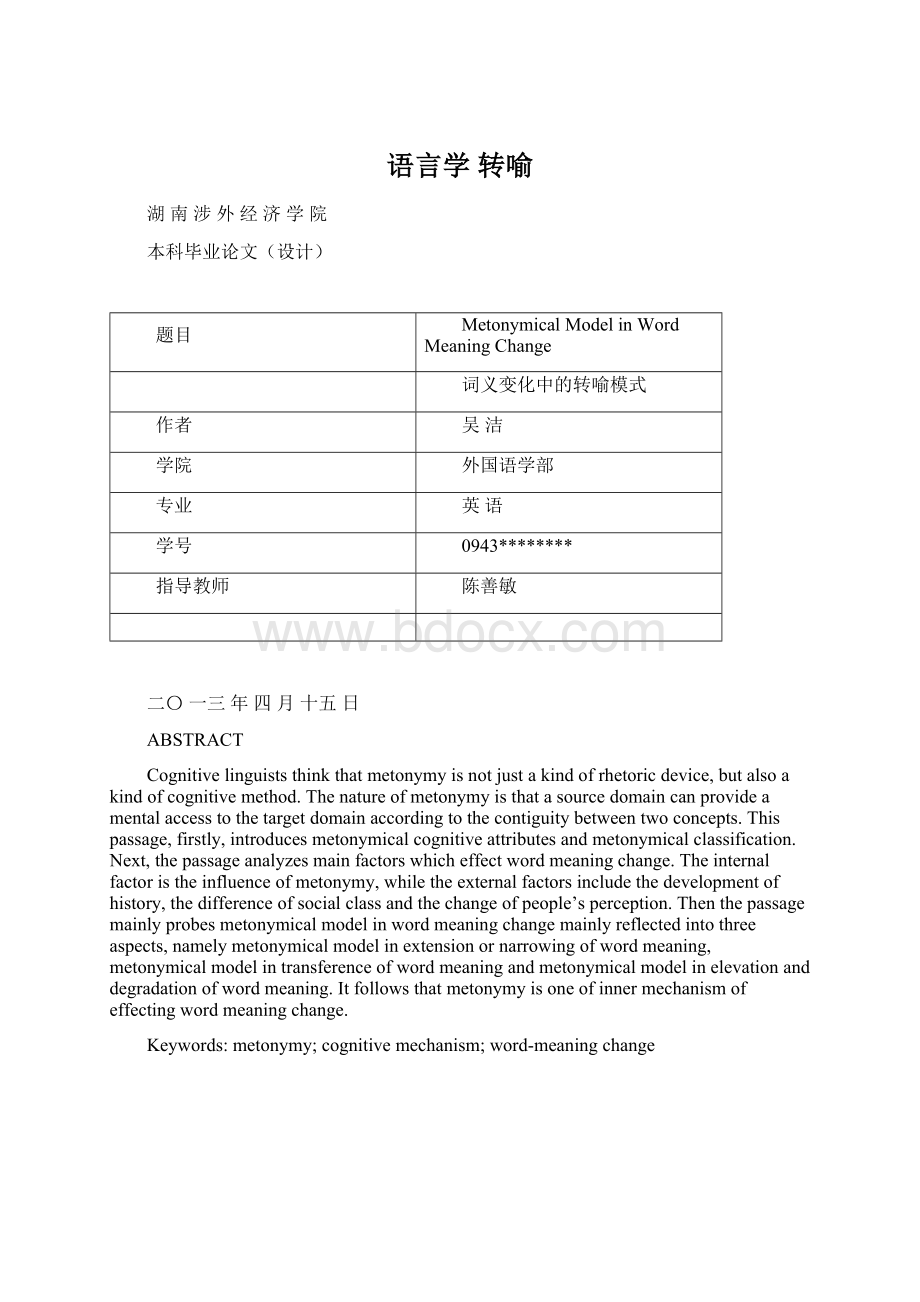 语言学转喻Word文件下载.docx
语言学转喻Word文件下载.docx
- 文档编号:18603115
- 上传时间:2022-12-29
- 格式:DOCX
- 页数:16
- 大小:32.21KB
语言学转喻Word文件下载.docx
《语言学转喻Word文件下载.docx》由会员分享,可在线阅读,更多相关《语言学转喻Word文件下载.docx(16页珍藏版)》请在冰豆网上搜索。

吴洁
学院
外国语学部
专业
英语
学号
0943********
指导教师
陈善敏
二〇一三年四月十五日
ABSTRACT
Cognitivelinguiststhinkthatmetonymyisnotjustakindofrhetoricdevice,butalsoakindofcognitivemethod.Thenatureofmetonymyisthatasourcedomaincanprovideamentalaccesstothetargetdomainaccordingtothecontiguitybetweentwoconcepts.Thispassage,firstly,introducesmetonymicalcognitiveattributesandmetonymicalclassification.Next,thepassageanalyzesmainfactorswhicheffectwordmeaningchange.Theinternalfactoristheinfluenceofmetonymy,whiletheexternalfactorsincludethedevelopmentofhistory,thedifferenceofsocialclassandthechangeofpeople’sperception.Thenthepassagemainlyprobesmetonymicalmodelinwordmeaningchangemainlyreflectedintothreeaspects,namelymetonymicalmodelinextensionornarrowingofwordmeaning,metonymicalmodelintransferenceofwordmeaningandmetonymicalmodelinelevationanddegradationofwordmeaning.Itfollowsthatmetonymyisoneofinnermechanismofeffectingwordmeaningchange.
Keywords:
metonymy;
cognitivemechanism;
word-meaningchange
摘要
认知语言学认为,转喻不只是一种修辞手法,它还是一种认知方式,其本质是借助两个概念之间的邻近性而达到相互的通达。
文章首先介绍了转喻的认知属性及转喻的分类。
接下来,文章分析了影响语义变化的主要因素,内部因素主要是转喻的影响,外部因素主要包括历史发展,社会阶层的不同和人们观念的变化。
然后文章重点探讨了词义变化中的转喻模式,主要体现在三个方面,即词义扩大或缩小的转喻方式、词义转移的转喻方式、词义褒贬演变的转喻方式,由此得出,转喻是影响词义变化的内在机制之一。
关键字:
转喻;
认知机制;
词义变化
Contents
AbstractI
摘要II
Introduction1
Chapter1WhatIsMetonymy3
1.1TraditionalMetonymyConcept3
1.2CognitiveNatureofMetonymy4
1.3ClassificationofCognitiveMetonymy5
Chapter2CausesforWord-MeaningChange9
2.1ExternalFactors9
2.2InternalFactors10
Chapter3MetonymicalChangeinWordMeaning13
3.1MetonymicalextensionorNarrowingofWordMeaning13
3.1.1Thesalienceonpsychologicalperception13
3.1.2Theconventionalizedsalience16
3.2MetonymicalTransferenceofWordMeaning16
3.3MetonymicalElevationorDegradationofWordMeaning17
Conclusion19
Bibliography20
Acknowledgements21
Appendix:
InformativeChineseAbstract22
Introduction
Metonymy,likemetaphor,isgroundedinourexperienceandallowsustoconceptualizeonethingbymeansofitsrelationtosomethingelse.(LiaoGuiyan&
CuiXiumin2007:
34-35)Inrecentyears,metonymyandlexicaldevelopmenthavebeengraduallypaidattentiontobydomesticandforeignlinguists.Oneofthemostpopularexplanationsformetonymycomesfromthecognitivelinguists.Theythinkthatmetonymyisnotasimplerhetoricaldecoration,butamaincognitivetoolandthinkingwayofhumanbeings.Theachievementofforeignmetonymyresearchismainlyshowedintheresearchofmetonymicnatureandmetonymicclassification.TheearliercognitivelinguistsLayoff&
Johnsonbelievethatmetonymyisaprocessofconceptualizationofthingsthroughthecontiguityrelationshipwhichjustexplainsmetonymicnatureinbroad-brushoutline.Laterthelinguistsstudymetonymyincognitivedomainandthinkmetonymyisaconceptualmappinginacognitivedomain,whichismainlyreferentialfunction.Croftarguesthatmetonymyisthehighlightingofcognitivedomainindomainmatrix.Panther&
Raddenbasedontheformerresearch,thinkmetonymyisacognitiveprocessintheidealizedcognitivemode.Inthisprocess,aconceptprovidesthementalaccesstoanotherconceptandetc.(ZhuangDongwei2012:
18)ThedomesticscholarShenJiaxuan,however,introducesmetonymyincognitiveviewwhoregards“destructure”asabreakthroughpointandbelievesthattransferredreferenceingrammarisessentiallymetonymywhichisagenerallycognitivewayembodiedingrammar,itcanbecalled"
grammaticalmetonymy"
.ChenYuandZhaoHuajunthinkthatmetaphormechanismisthecognitivebasisofpolysemywhilemetonymymechanismisthemaincognitivemotivationofclassconversion.(ZuangDongwei2012:
19)Basedontheresearchofmetonymyathomeandabroad,wewillanalyzethefunctionofmetonymyaboutwords.
Langackerthinksthatlanguagecommunicationisdominatedbyinformationalmaximizationandlanguageeconomicalprinciple.Theinformationalmaximizationprinciplesuggeststhatspeakerstrytoaccuratelyconveymostofinformationas
muchaspossiblewhilelanguageeconomicalprinciplesuggeststhatspeakersconvenientlyconveyinformationasmuchaspossible.Thatistosay,applyingthecognitivesalienceprinciplemeansapplyingthelanguageeconomicalprinciple.Betweenhumansandnon-humans,thewholeandthepart,thespecificandabstract,andvisibleandinvisible,theformerismoresalientthanthelater.Sometonymycanmakelanguageseasilyunderstood.Besidesthemetonymyresearchcanincreasethedeepunderstandingofhumans.Metonymyisanunconsciouslycognitiveprocessandanimportantmeansofenrichinglanguages.Whenonecognitivemethodhasshortcomings,wecanuseanothermethodtosupply.Andmetonymyhasplayedthiskindofroletoaddlexicalgap.What’smore,metonymyprovidesaveryusefulmethodforustomemorizewords.Whenwehavememorizedoneword,wemaymemorizemorerelatedwordsaccordingtometonymy.Forexamplewhenwememorizethewordhead,wemaymemorizetherelatedwordhairorhairstyleetc.
Thispassageinterpretstheword-meaningchangefromacognitiveperspectiveofmetonymyanditprovesthatcognitivemetonymytheorycanaccountmuchforword-meaningchange.Thisthesisconsistsofthreechapters;
thefirstchapterisaboutwhatmetonymyiswhichincludestraditionalmetonymyconcept,cognitivenatureofmetonymyandclassificationofcognitivemetonymy.Thesecondchapterisabouttheexternalandinternalcausesofword-meaningchange.Thethirdchapterisaboutthemetonymyeffectsonwordmeaningchangeelaboratedfromthreerespects:
metonymy’seffectsonword-meaningextensionornarrowing,onword-meaningelevationordegradation,andonword-meaningtransference.
Chapter1WhatIsMetonymy
Metonymyisnotjustafigureofspeech;
itplacesasignificantroleinhumancognitionasawayofthinking.Inordertoletusknowmoreaboutmetonymytheory,weintroducethischapterandfocusourdiscussionontraditionalmetonymyconcept,metonymynatureandclassification,andmetonymycognitivemechanism.
1.1TraditionalMetonymyConcept
ThewordmetonymywasderivedfromGeekmetonymiawhichmeanschangeofname.InAdvancedLearner’sEnglish-ChineseDictionary,metonymyreferstotheactofreferringtosomethingbythenameofsomethingelsethatiscloselyconnectedwithit.ThetraditionalmetonymyconceptregardsmetonymyasakindofsubstitutionrelationswhichcanbeformalizedasXSTANDFORY.TheearliestmetonymyconceptwasderivedfromthebookRhetoricandExplanation.Itindicatesthatmetonymyisakindofrhetoricaldeviceanditobtainslanguagefromneighboringandcloselylinkedthings.Thenwecanunderstandthewordsnottobenamedthroughtheformoflanguage.Fromthisdefinition,wecanseethatthetraditionalconceptofmetonymyisbasedontheconceptofcontiguity.TheconceptofcontiguityisalsoreflectedinRoudet’sdefinitionofmetonymy,inwhichhepointsoutthatmetonymyiscausedbyanassociationbasedonaconceptualadjacencyandanycontactormetonymychangesofthiscategory.(ZhangHui&
SunMingzhi2005:
15).Thereareninetypesofcontiguity-relationsinmetonymyaccordingtoF.UngererandH.J.Schmidt:
1)artforwhole,2)wholeforpart,3)containerforcontent,4)materialforobject,5)producerforproduct,6)placeforinstitution,7)placeforevent,8)controlledforcontrollerand9)causeforeffect.(Ungerer&
Schmid1996:
121)
However,withthedeepeningofstudyandtheprosperityofcognitivelinguistics,itisfoundthatthenatureofmetonymyisnotjustafigureofspeechbutacognitivetool.Nextwewillintroducecognitivenatureofmetonymy.
1.2CognitiveNatureofMetonymy
Incognitivedomain,metonymyisacognitivephenomenon,ameansofextendingtheresourcesofalanguage.Metonymyisnotonlythenaturalrelationbetweenexperiencestructureandlanguagestructureofhumanbeings,butalsotheresultsofco-developmentbetweencognitivethinkingandlanguageexpressionofhumans.Whenpeopleobserve,understandandinterpretobjectivethingswhichenterintopeople’smind,theyalwaysreasonandassociateaccordingtotheirownknowledgeandexperience.Thentheypickupapartamongconceptualcategoryfrommindandmapthispartontothingsfromoutsideworldsothatanimagecomesintobeing.Thenatureofmetonymybasedonimage-schemaandcontiguityrelationsusethesalientpartstoactivatethemetonymyobjectandthenusethepartofsalienceandimportancetosubstitutethewholeortheotherpartorusethewholetosubstitutestheparts.Forexample“therearealotofprettyfacesinthestreet”Inthissentence,metonymyinvolvestwocategories:
“faces”and“people”.“Faces”isthesourcecategoryand“people”isthetargetcategory.Metonymyinthesentenceistheresultachievedbymappingthesourcecategory“faces”ontothetargetcategory“people”.Thereasonwhyfacescanbecomethesourcecategoryisthatthefaceisimportanttopeople.Itreflectsthesalientprincipleofcognition.Asacognitiveprocess,metonymyisdefinedasthevehiclewhichprovidesmentalaccesstothetargetinthesamedomain.Metonymyinthecognitiveliteratureismodeledasidealizedcognitivemodels(ICMs)byLakoff,conceptualmappingbyRadden&
Kovecses,domainhighlightingbyCroft,combinationsofmappingsandhighlightingbyRuizdeMendoza,scenariosbyPanther&
Thornburgandmoregenerallyasreference-pointactivationbyLangackerandBarcelona.(HuZhuang-lin,2001:
132)
Cognitiv
- 配套讲稿:
如PPT文件的首页显示word图标,表示该PPT已包含配套word讲稿。双击word图标可打开word文档。
- 特殊限制:
部分文档作品中含有的国旗、国徽等图片,仅作为作品整体效果示例展示,禁止商用。设计者仅对作品中独创性部分享有著作权。
- 关 键 词:
- 语言学 转喻
 冰豆网所有资源均是用户自行上传分享,仅供网友学习交流,未经上传用户书面授权,请勿作他用。
冰豆网所有资源均是用户自行上传分享,仅供网友学习交流,未经上传用户书面授权,请勿作他用。


 铝散热器项目年度预算报告.docx
铝散热器项目年度预算报告.docx
